The African women’s international game has long been dominated by the likes of South Africa and Nigeria, who have produced some outstanding talent and who have generally been recognised as the ones to beat on the continent.
However, in the last few years, others have been looking to close the gap to those two nations, none more so than Zambia, who exploded onto the scene back in 2021 at the Tokyo Olympics and who have shown as the last few years have gone by that they hold no fear and will be a match for anyone who stumbles across their path.
Whilst their campaign three years ago did not produce much in the way of success, with their group games ending in a heavy loss to the Netherlands, a narrow defeat to Brazil and a breathtaking 4-4 draw against China, there was no doubt that they had made the world sit up and take notice of what they could do.
Fast forward to now, and they are back at the Games, looking to improve on their fortunes in Japan, and, as this tactical analysis will indicate, they are not a team that anyone should underestimate.
Predicted Starting XI
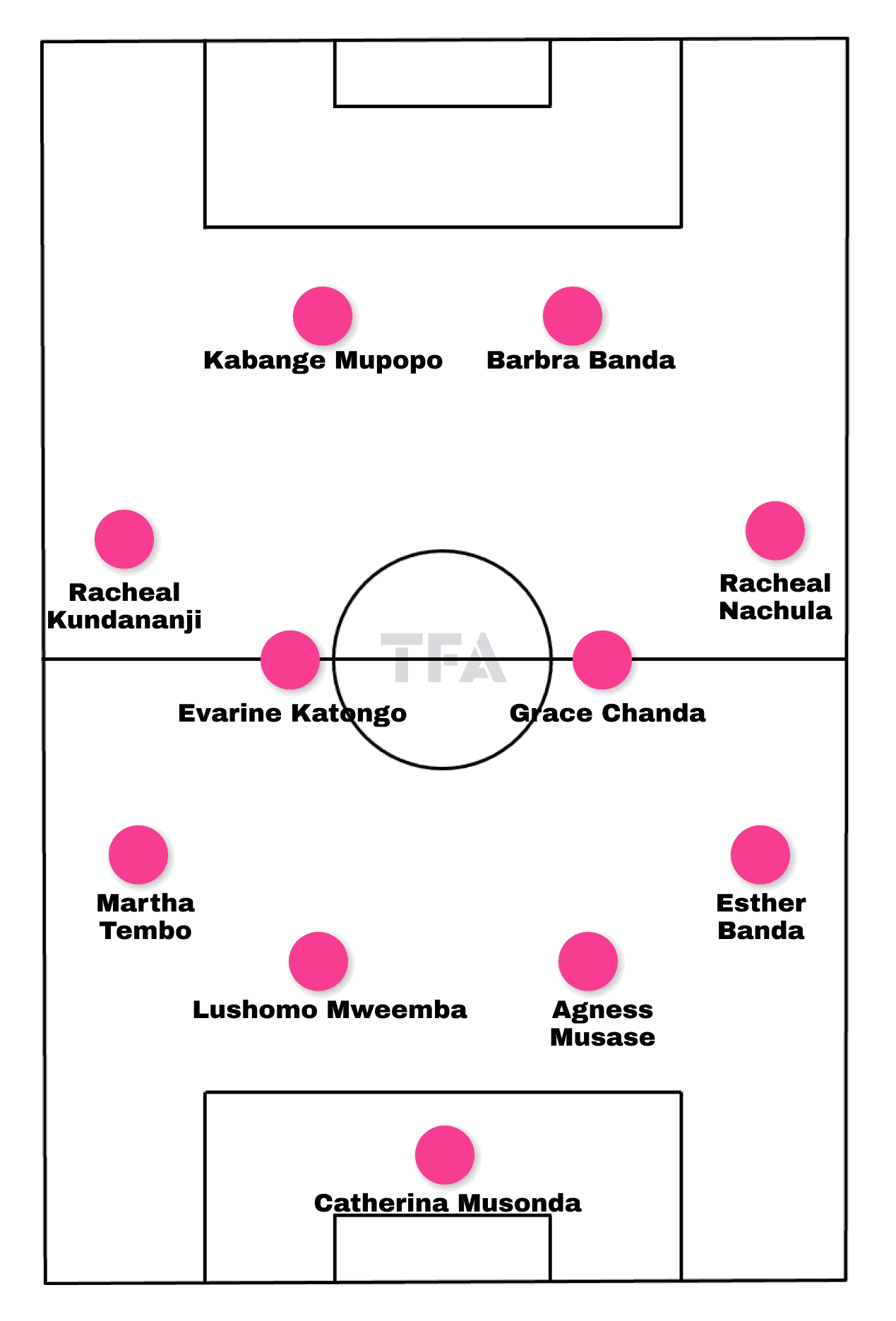
With Zambia favouring a 4-4-2 formation in most matches, their key priority when it comes to selecting their team is balance, with it clear that they need players who can help them to be compact and tough to break down but who can also push forward as soon as the ball has been regained.
With that in mind, the goalkeeper needs to be a player capable of both organising those ahead of them and of distributing across multiple distances, and both are things that regular starter Hazel Nali thrives in.
However, with her injured and set to miss the tournament, an alternative will be required, and the most logical choice appears to be Catherine Musonda, who missed both of their final qualifying matches against Morocco due to injury but who featured in the previous round against Ghana.
Therefore, if she is selected in the final squad, it seems likely that she will be given the nod once again.
Ahead of her, Zambia also have a few problems to solve, with there being question marks around right-back Margaret Belemu and central defender Agness Musase.
If selected, then the latter is likely to be included in the starting XI, with her partnership with Green Buffaloes Women teammate Lushomo Mweemba well-established, but Esther Banda impressed against Morocco whilst deputising at right-back and so it is not out of the question that she could be handed that role again, with Belemu potentially included on the bench.
The midfield is where Zambia need players with specific attributes, with the fact that there are no holding midfielders or playmakers in the team, meaning that those in the central positions have to be effective at both shielding the backline and offering support in attack.
With that in mind, it is very likely that Grace Chanda will start matches, should she be included in the team, with her always a key name in the Zambian ranks and one that they rely on both with and without the ball.
Her partner in that area is less certain, but the fact that Evarine Katongo has impressed in the central third and has the ability to offer what Zambia need means that she also has a good chance of being included.
Zambia likes to attack in numbers when they have the ball, which means that those on the wings have to be adept at getting forward to stretch opposing defensive lines out.
The duo of Racheal Nachula and Bay FC’s Racheal Kundananji certainly offer that in abundance.
Kundananji, in particular, will not be a player that opposing sides should ignore, which is why her presence might help unsettle opposing backlines.
At the top of the field, Zambia once again have options and it will depend on what head coach Bruce Mwape is looking for as to who is handed a start in the front line.
Both Kundananji and Nachula are options in those roles should there be a desire for them to get further inside the pitch, but the fact that both are likely to at least start the tournament as wide attackers means that Kabange Mupopo could partner the aforementioned Banda in leading the attack, should the former be included in the 18 players heading to France.
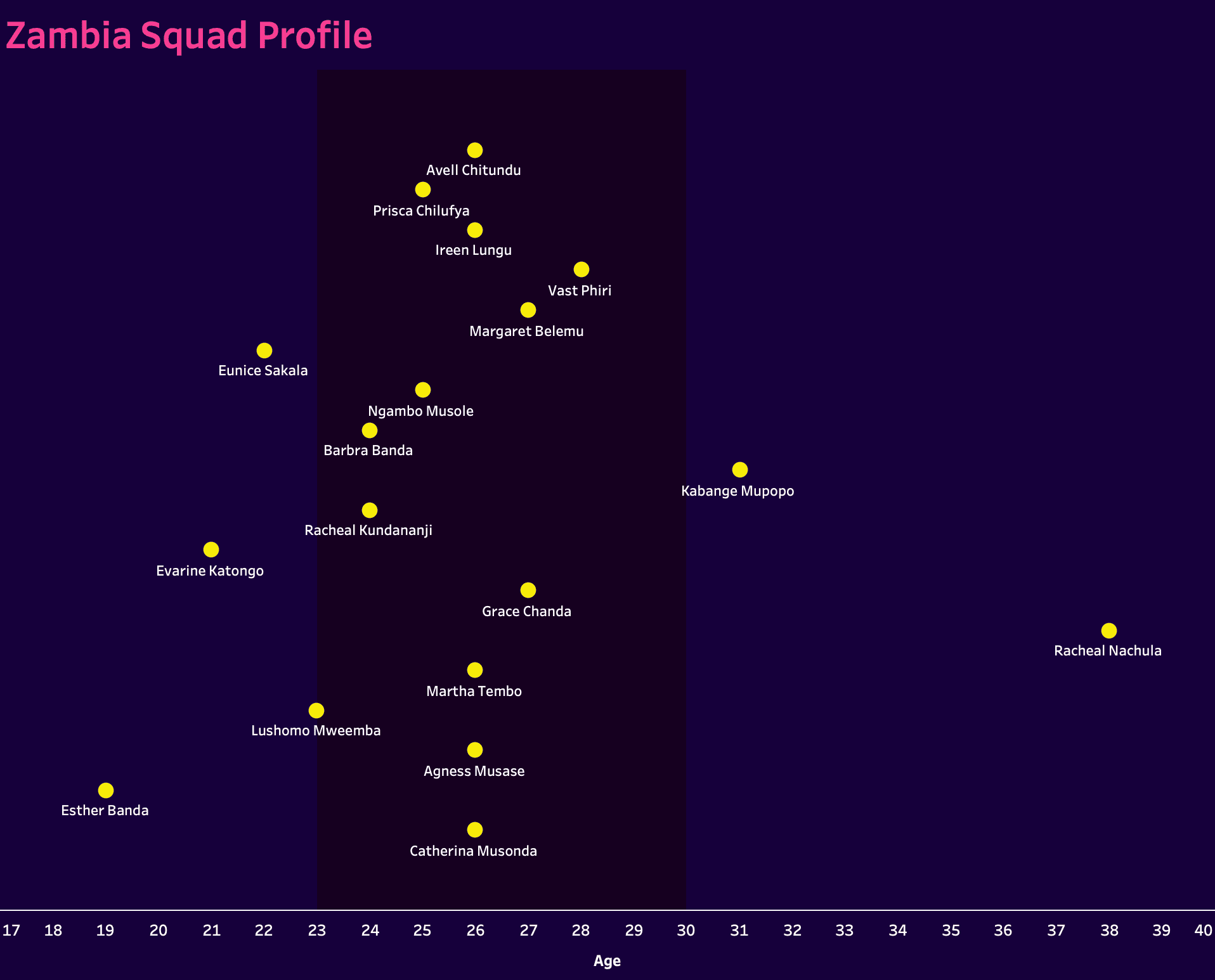
When breaking down Zambia’s squads in previous tournaments, what has always been clear is that they like to have the same group of players in each one as they look to develop partnerships around the field.
With that in mind, most of those likely to be on the plane are players who have been selected beforehand and who are, therefore, at the height of their careers, with them having the experience to know how to deal with the pressure of performing at this level but also having the ability to feature in multiple games across a short time span.
That does not mean that they look down on more experienced options, and the fact that both of those over the age of 30 have been named in the potential starting XI does highlight that they do have a need for long-serving players to glue the team together.
However, the fact that there are only two who could be included in the 18-player list does show that Zambia don’t rely too heavily on those who are nearing the end of their careers, and it could be that they are the ones who swap in and out of the team as Mwape looks to make tweaks ahead of each outing.
Attacking Phase

It has been established already in this scout report that Zambia are a side who put a lot of emphasis on their attacking play, but what is important to remember is that they are not only a one-person team.
Instead, Banda is just one of a number who can test opposing rearguards, and having a rich variety of players who can get up the field is one of the reasons that they have averaged two goals per game this year and scored 1.78 times per outing in 2023.
Being able to rotate who is providing the key threat becomes increasingly essential when opponents look to close Banda down, and Ghana were one side whose game plan revolved around limiting her influence on proceedings.
In this case, Susan Ama Duah is the one tasked with preventing her from gaining any territory once the ball arrives at her feet, and it did perhaps appear as though that would be enough to force Zambia into sending the ball backwards.
However, Ghana ignored the presence of Mupopo and Kundananji either side of the ball, and that proved to be costly as Banda was able to find the latter and set up the only goal of the game.
Therefore, even if the Orlando Pride striker, who has been in fine form in the NWSL so far, is marked out of the match, teams have to be aware of other players who can replicate what she offers; otherwise, they will end up going the same way.
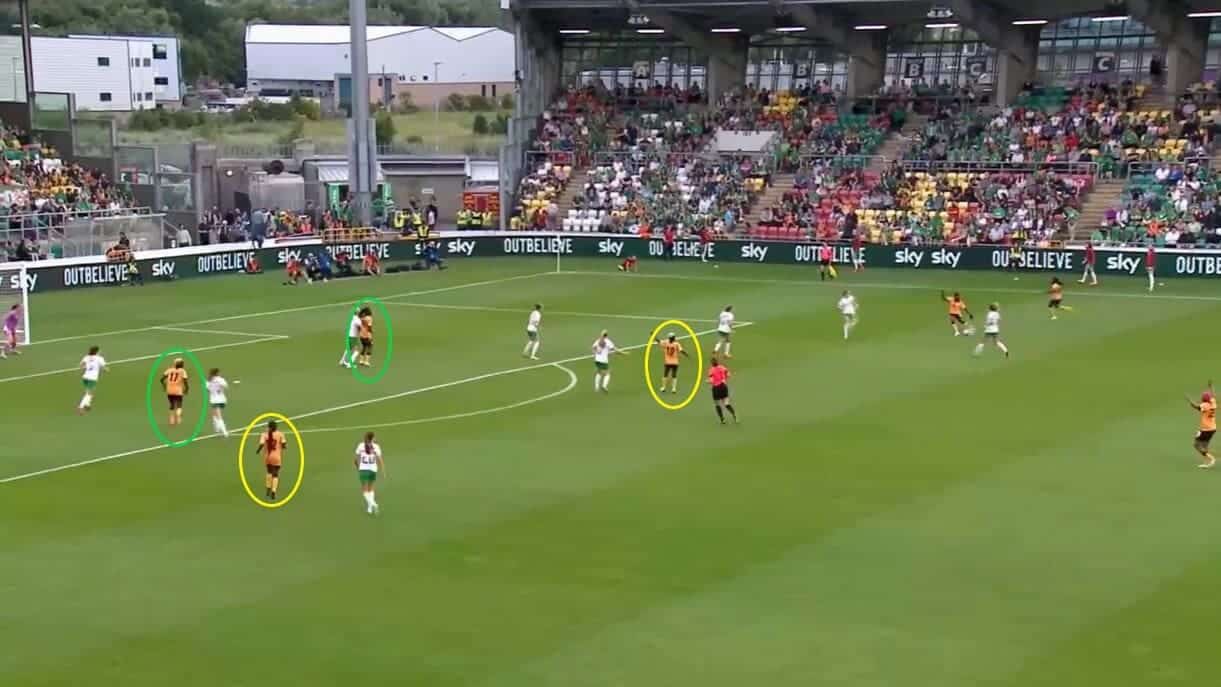
Zambia’s attacking play is a team effort, and this theme has been shown in other ways.
In this case, the ball is on the far side of the field, and both Banda and Kundananji have made their way into the goal area to provide immediate targets for the delivery.
However, the key players to point out here are Katongo and Chanda, who have taken up positions just behind them and are providing a secondary attacking presence.
Having them around the goal area proves to be critical in this situation as the Republic of Ireland manage to clear the initial delivery through Liverpool Women captain Niamh Fahey beating Kundananji in the air, but they don’t manage to end the chance completely as the ball only falls at the feet of Katongo.
As a result, Zambia can keep their opponents on the back foot and can maintain the pressure on them, which is another reason that they will be a tough side to keep out.
Defensive Phase
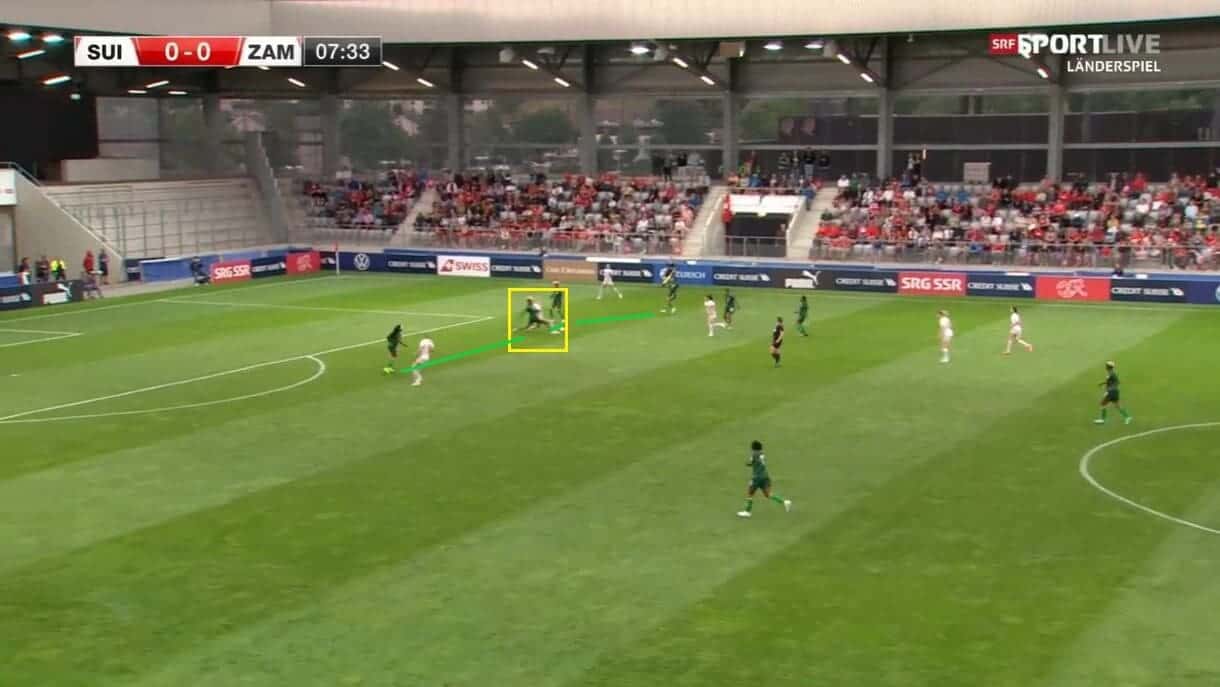
As mentioned at the beginning of the analysis, Zambia’s desire as soon as they lose the ball is to be solid at the back and to ensure that they never make it too easy for opponents to break them down.
However, as is perhaps to be expected by a team who like to control games, they don’t tend to sit back and wait for the ball to come to them, and instead, it is common to see them playing with a high backline and trying to regain possession as quickly as possible.
In this case, that has seen Switzerland forward Alisha Lehmann closed down by Musase, and the fact that they as a team have won 53.1% of their defensive duels this year and succeeded in 66.4% of them last year indicates that this is not a one-off.
The downside of playing with a high backline, though is that it does leave space open behind for teammates to exploit, and that is what has led to Zambia conceding 1.5 goals per game this year and letting in 2.67 in 2023.
In this case, whilst Lehmann was unable to find a way through, Switzerland did score just a couple of phases later through former Atlético Madrid Femenino forward Ana-Maria Crnogorčević, with her taking advantage of Belemu stepping out of line to send the ball into the back of the net, and so that is something that Zambia will have to be aware of when they make the trip to France.
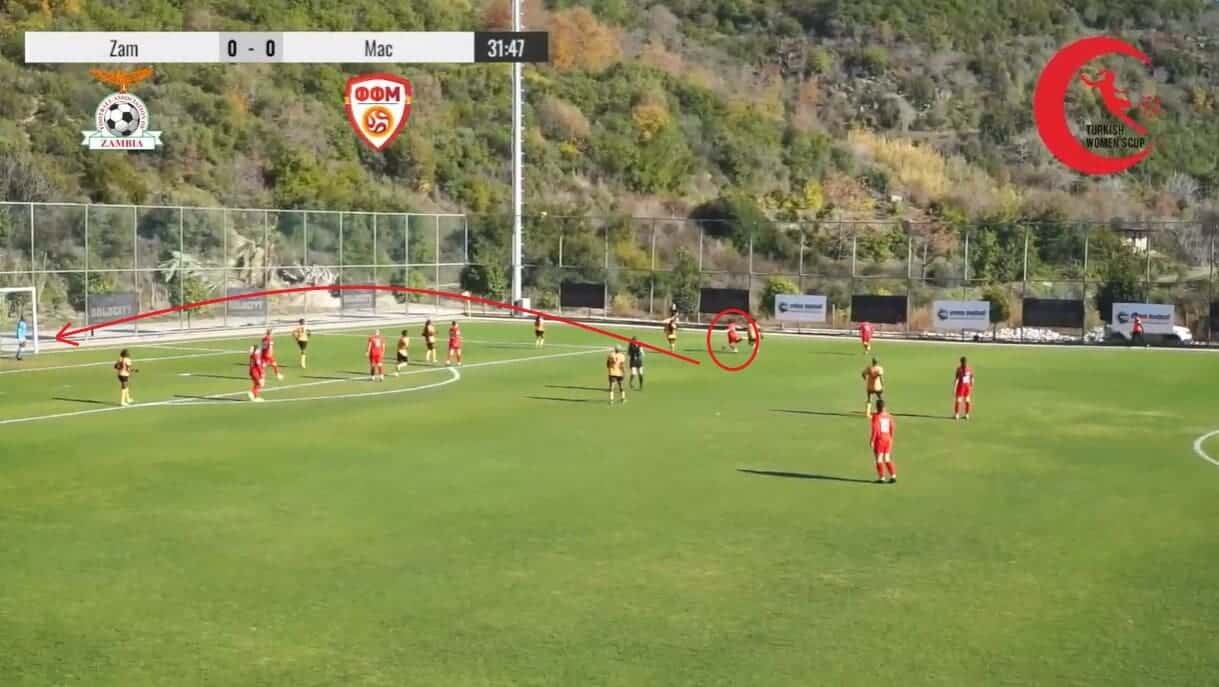
This is not to say that Zambia always looks to press its opponents, though.
There have been some games when they have shown adaptability.
Against both Uzbekistan and North Macedonia in the 2023 Turkish Women’s Cup (an annual friendly tournament), they realised that both sides were looking to send balls into the middle from the wings and so based their own tactics around staying back and ensuring that they won those first balls.
In this case, that proved to be a successful game plan to employ as North Macedonia midfielder Mila Talevska saw her cross easily gathered by Nali, and it is always important to be organised against them as they are a team who can threaten in central spaces if given the opportunity to do so, with the likes of KuPS Naiset’s Gentjana Rochi and Nataša Andonova, formerly of Levante Femenino, among their ranks.
What that, therefore demonstrates is that Zambia can change their mentality depending on who they are coming up against, which will be vital if they are to put on a good showing when the Olympic action gets underway.
Transitions
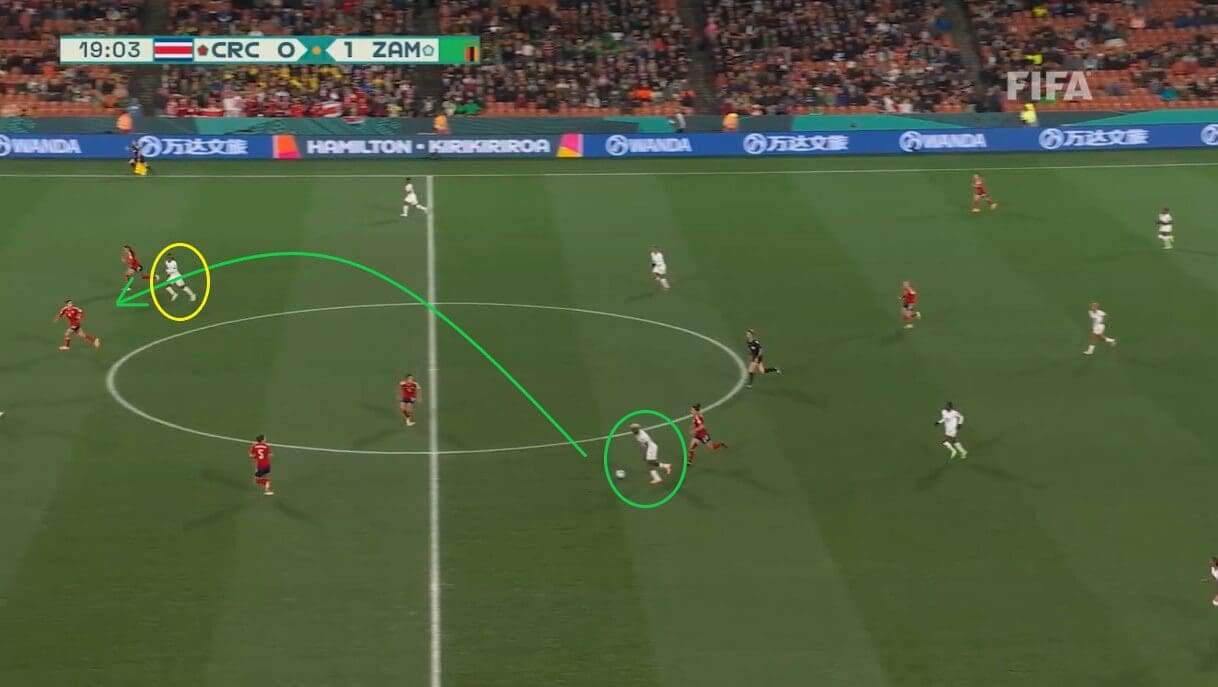
The fact that Zambia set up in a 4-4-2 shape, which is not renowned for affording teams much positional freedom, means that they have needed to rely on the accuracy of their passing when constructing attacks.
However, with 58.2% of their passes this year and 73.5% of them in 2023 finding their intended targets, it is clear that this is one of their strengths, and so is never something that concerns them, and this situation highlights how precise they can be.
However, whilst the pass from Kundananji to Banda is pinpoint and has allowed Zambia to move the ball from one end to the other in an instant, the key thing to point out is what happens after that, with Zambia pushing players up the field as soon as the ball had been shifted forwards in order to give themselves the best possible chance of keeping their attack alive.
Doing so was crucial here as Banda was at this stage on her own against a Costa Rica defensive line that were known for winning first balls under now-Monterrey Femenil head coach Amelia Valverde, and so the arrival of reinforcements ensured that Zambia were able to keep the pressure on even with their opponents initially clearing their lines through Mariana Benavides.
It is details such as this that has seen 60% of their counterattacks in 2024 and 72% of them in 2023 ending in a shot on goal, and it would not be a surprise to see them employ similar tactics in transitional phases in France in order to be as productive as possible whenever they do have the ball.
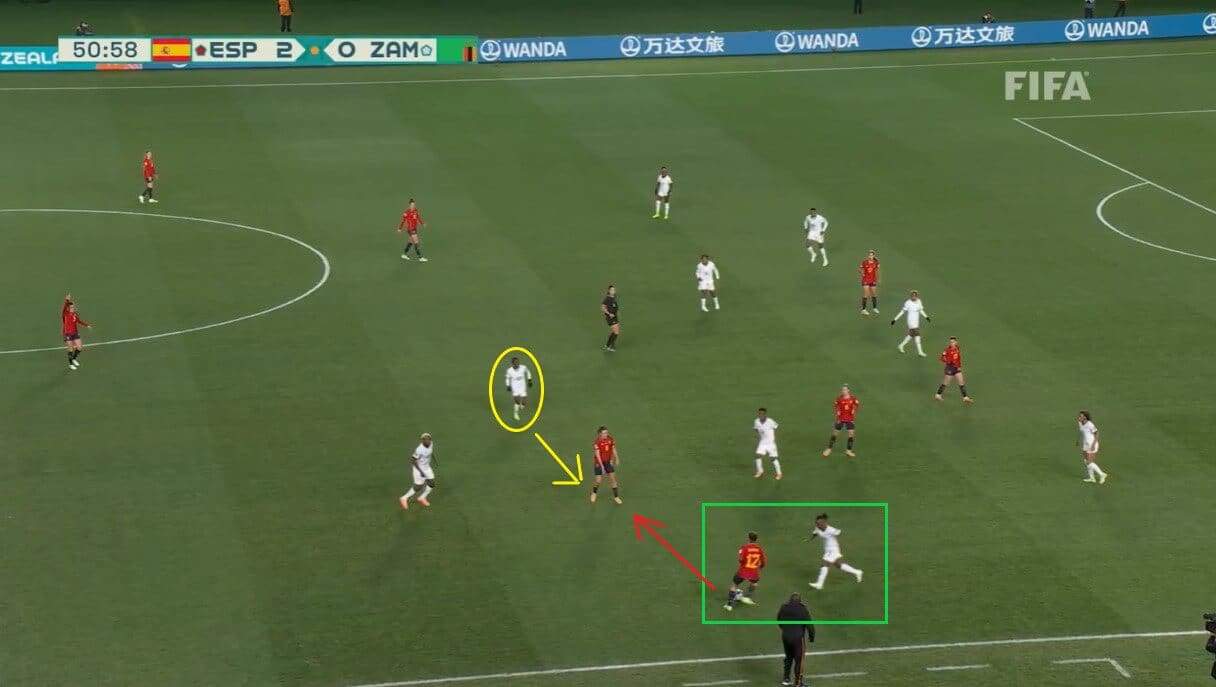
As soon as possession has been conceded, Zambia’s attention instantly turns back towards staying organised and keeping as much distance between the ball and their goal as possible, and the speed with which they get back and take up their positions is the key thing to note, with it demonstrating how well-drilled they are and how each player knows what they need to do as soon as their opponents look to push up the field.
As a result of that, opposing teams never find it easy to counterattack with much success against them, and Spain found that out here as Real Madrid Femenino full-back Oihane Hernández was able to pass inside the field towards Mariona Caldentey, despite being closed down quickly by Avell Chitundu, but the combined effort of Katongo and BIIK Shymkent’s Ireen Lungu ensured that that was as far as Spain got.
Given that Zambia will be facing three teams in the USA, Germany, and Australia that will likely look to dominate the ball, they may need to rely on their defensive shape for long periods of their games.
Their ability to be tough to break down will stand them in great stead as they look to frustrate their opponents and give themselves the best possible chance of reaching the knockout stages.
Forwards
With it now apparent what Zambia’s tactical appearance will be, attention turns towards who they could take with them and who will give them the best possible chance of exerting their influence on the field.
What will be crucial with only 18 places in the squad is versatility.
Including different profiles of players will be especially vital when it comes to the forward line, with both Banda and Mupopo tending to play high up the field and to offer target players.
Hence, Zambia perhaps need someone who can help to bridge the gap and who can drop deeper at times in order to ensure that they can switch their game plan around in those games when staying high is not having the desired effect.
Kundananji would be capable of offering that, but the inclusion of Prisca Chilufya could also help to give them that variety, with her demonstrating last season for Juárez Femenil that she is not only a player who can threaten opposing goals but who can create from behind the forward line too.
Any team that wants to succeed in tournaments needs to demonstrate tactical flexibility as they go on.
No two games are ever the same, and the ability to alter the system and to switch the team’s mentality will be vital if Zambia is to be at its best when the Olympics get underway later this month.
Midfielders
That theme of having players with different profiles continues when looking at Zambia’s midfield options.
Chanda and Katongo are likely to start most matches but tend to bring the same things to the table, thus providing the same issue as Banda and Mupopo.
However, having Lungu in the squad will undoubtedly remedy that.
While she is at her best when playing further forward, she has been known to sit a little deeper in some games.
As a result, she could come in when Zambia are under sustained pressure at the back to offer defensive protection while also giving whichever player she is deployed alongside greater freedom to push further up the pitch.
Therefore, again, Zambia might appear from their potential starting XI to be quite one-dimensional, but they have ways of introducing layers when necessary, and that will be critical as the matches go on.
Defenders
When it comes to the defensive options that Zambia could take to France, there is less of a need for versatility and more for cover in the positions that they are slightly unsure about at this moment in time.
It has already been mentioned that Belemu, in particular, is a doubt due to her recent army training (with her being one of a number of players who serves in the Zambian armed forces alongside her football career), with Banda likely to be the main alternative at right-back if she is not included, but the other player that could join their defensive contingent and who could bring much-needed cover across the backline is Vast Phiri.
At 28 years old, she has plenty of tournament experience that could be of enormous benefit to Zambia as the matches go on, and so it would not be a surprise to see her included for that reason and because she has the ability to slot in wherever needed.
Key Player
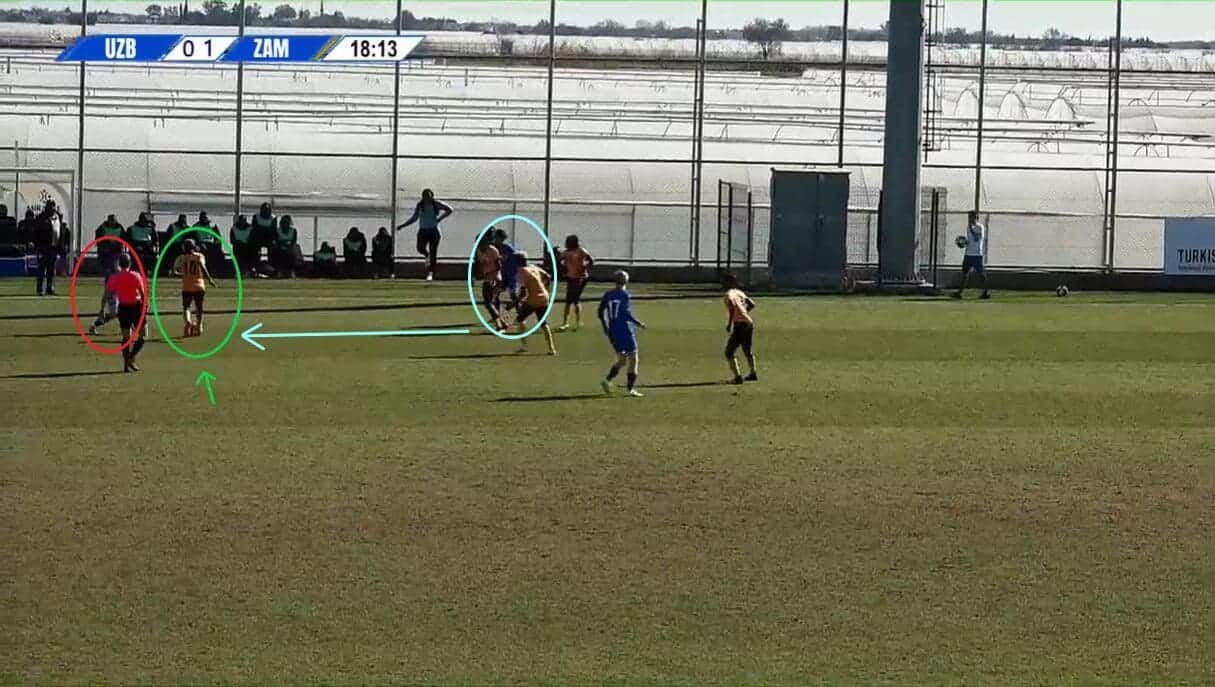
Whilst there is no doubt that the spotlight will be on the attacking duo of Banda and Kundananji, given that they are currently the most expensive female footballers on the planet, the player who could prove to be critical to Zambia’s hopes of making it out of their group stage is the aforementioned Chanda.
Her ability to be an all-rounder on the field, as has been highlighted throughout this scout report, means that she will be a vital player for them both with and without the ball.
Undoubtedly, each of Zambia’s opponents will need to be aware of her presence and limit her influence if they are to prevent the African nation from settling into their rhythm.
Her key role once her team loses the ball is to lead their attempts to win it back as early as possible, and it is common to see her reading what is happening around her and making vital interceptions as a result.
In this case, she anticipated the pass that Uzbekistan’s left wing-back Umida Zoirova would make towards Irodakhon Turdalieva, which successfully disrupted their attempt to build an attack.
Doing so was vital in this match, as Uzbekistan had set up with a back three/five formation and had based their tactics around outflanking Zambia and negating their midfield threat.
Chanda, by making these contributions, prevented them from catching her side out where they were less protected.
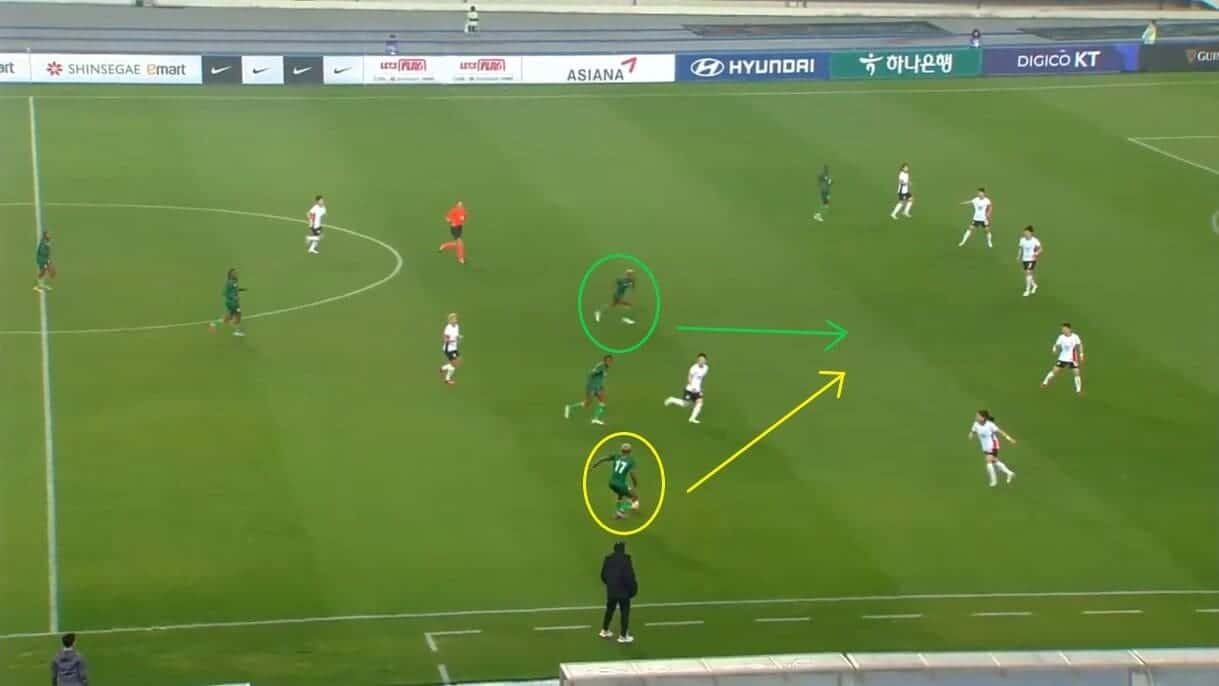
Once her team have the ball, Chanda’s focus turns instantaneously towards providing passing options in forward areas, with it already mentioned that she is a naturally attack-minded player who likes to operate as high up the field as possible.
In this game, South Korea tended to sit back and focus on being defensively robust, so there was always space in front of their backline for Zambia to exploit.
Chanda has taken advantage of that in her bid to ensure that Zambia can continually progress up the pitch.
However, the key point to mention here is that she makes her run before Kundananji has controlled the pass from Ochumba Lubandji, and that highlights once again how she is so adept at reading the game and at knowing what is going on around her.
The move might not have led to anything due to the pass towards her being overhit, but there is no doubt that this will make Chanda such a dangerous player for opponents to leave unmarked during the upcoming tournament and underestimating her influence on their overall play will be perilous.
Tournament Prediction
There is no doubt when bringing everything together that Zambia have the potential to trouble their opponents, and they will enter this year’s Olympic tournament with high hopes of improving on their 2021 showing as they look to further demonstrate their potential to compete on the world stage.
However, given that they have been grouped with a rejuvenated USA (who will be eager to prove that they have turned a corner under former Chelsea Women manager Emma Hayes), a Germany team that looks like tough opponents, and an Australia side with quality rippling through their squad, the likelihood is that they will struggle to pick up enough points to make it out of the group stages, and so could fall just short.
Nevertheless, they are certainly an enjoyable team to watch and one that approaches games in the right way.
They will certainly be worth keeping an eye on as the action unfolds.




Comments